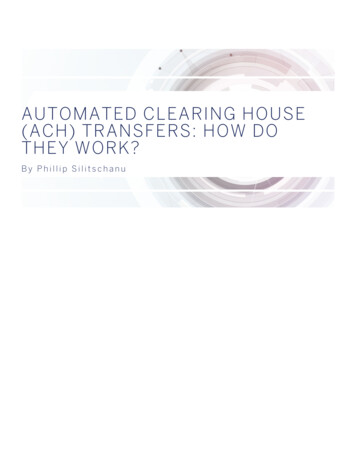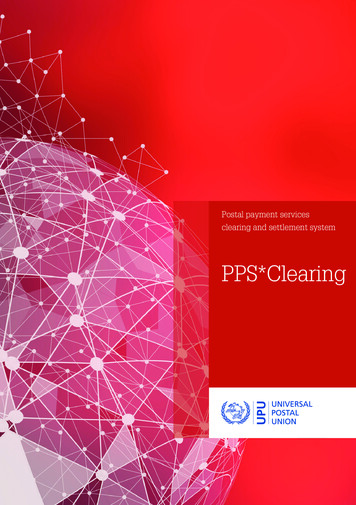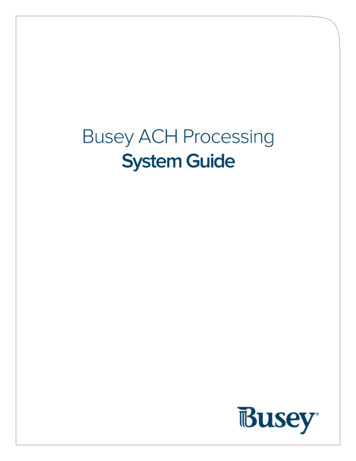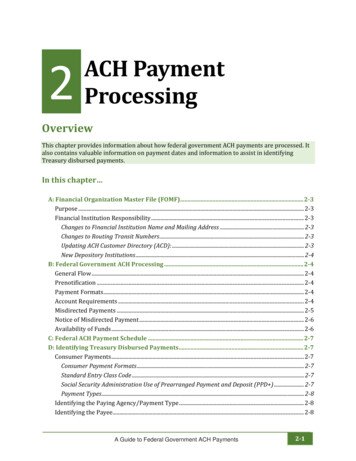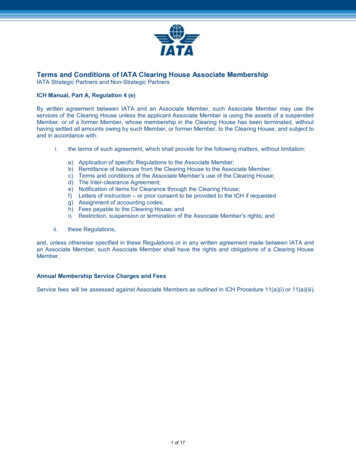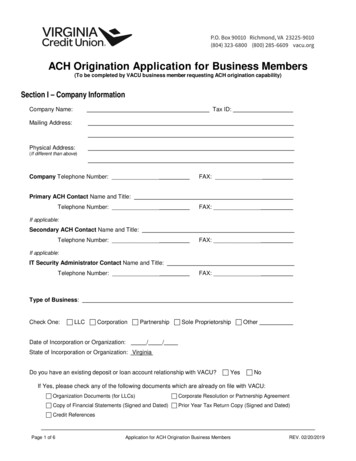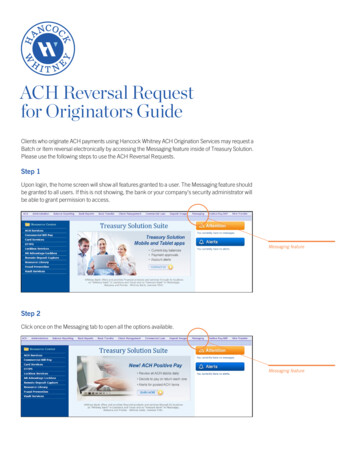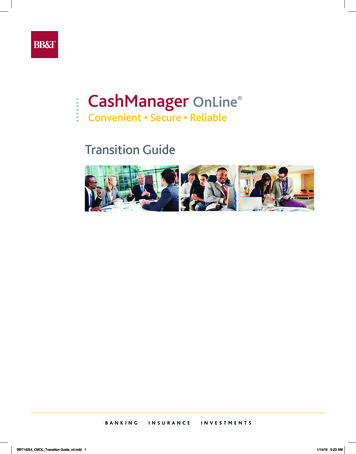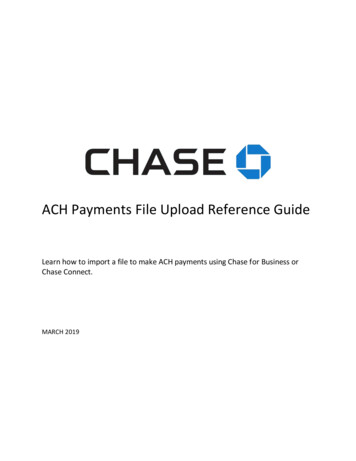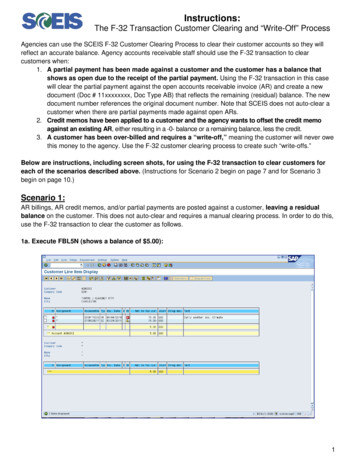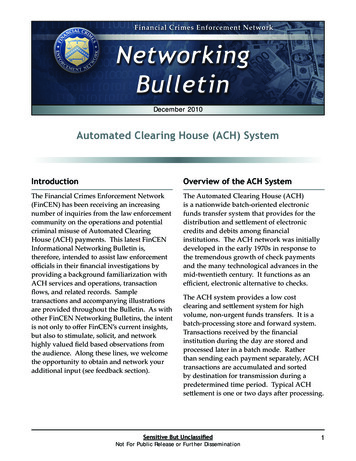
Transcription
December 2010Automated Clearing House (ACH) SystemIntroductionOverview of the ACH SystemThe Financial Crimes Enforcement Network(FinCEN) has been receiving an increasingnumber of inquiries from the law enforcementcommunity on the operations and potentialcriminal misuse of Automated ClearingHouse (ACH) payments. This latest FinCENInformational Networking Bulletin is,therefore, intended to assist law enforcementofficials in their financial investigations byproviding a background familiarization withACH services and operations, transactionflows, and related records. Sampletransactions and accompanying illustrationsare provided throughout the Bulletin. As withother FinCEN Networking Bulletins, the intentis not only to offer FinCEN’s current insights,but also to stimulate, solicit, and networkhighly valued field based observations fromthe audience. Along these lines, we welcomethe opportunity to obtain and network youradditional input (see feedback section).The Automated Clearing House (ACH)is a nationwide batch-oriented electronicfunds transfer system that provides for thedistribution and settlement of electroniccredits and debits among financialinstitutions. The ACH network was initiallydeveloped in the early 1970s in response tothe tremendous growth of check paymentsand the many technological advances in themid-twentieth century. It functions as anefficient, electronic alternative to checks.The ACH system provides a low costclearing and settlement system for highvolume, non-urgent funds transfers. It is abatch-processing store and forward system.Transactions received by the financialinstitution during the day are stored andprocessed later in a batch mode. Ratherthan sending each payment separately, ACHtransactions are accumulated and sortedby destination for transmission during apredetermined time period. Typical ACHsettlement is one or two days after processing.Sensitive But UnclassifiedNot For Public Release or Further Dissemination1
ACH settlement is the actual transfer of thevalue of funds between financial institutionsto complete the payment instruction of anACH entry. The Federal Reserve providessettlement services for all ACH entriesprocessed by the two ACH operators:FedACH (operated by the Federal Reserveitself) and EPN (a private sector operator.)The Federal Reserve receives the net credit anddebit positions of financial institutions andapplies those credits or debits to the reserveaccounts of the financial institutions (or theircorrespondent banks) that are maintained onthe books of the Federal Reserve.ACH Service OptionsInitially, the ACH system was used forrecurring funds transfers between knowncounterparties for payments such as payrolldirect deposit. The ACH system nowsupports an increasing number of one-timetransfers, such as online debits (InternetInitiated Entries), and has also expandedto international ACH payments. The ACHsystem supports a wide variety of corporate,individual, and government payment needs,as delineated in Part II below. Direct Payment of consumer billssuch as mortgages, loans, utility billsand insurance premiums, installmentpayments, membership dues, or otherrecurring obligationsThe National Automated Clearing HouseAssociation (NACHA), a consortium ofindividual financial institutions and regionalpayment associations, establishes the rulesunder which the ACH system operates andthe special terms used to describe ACHoperations. (Terms having special meaningunder ACH rules, such as “Originator”and “Receiver,” are explained in Part IIIbelow). NACHA periodically updates theACH operating rules to provide financialinstitutions with new ACH options and toaddress perceived problems.1.The following are various financial services(“options”) for which ACH is commonlyused for:ACH credits: Direct Deposit of payroll, Social Securityand other government benefits, and taxrefunds Customer-Initiated Transactions, such asbill paymentsConsumer initiated ACH debits: E-checks (check conversion) Internet and telephone payments (ACHdebits for online or over-the-phonepurchases)1Corporate initiated ACH applications: Federal, state and local tax payments Business-to-business payments, allowingcompanies to exchange both data andfunds with trading partners, facilitatingan automated process of updating theiraccounts receivable and accounts payablesystemsNACHA estimates that the majority of Internet-initiated payments are used to pay bills via companies’ or billingservices’ web sites.Sensitive But UnclassifiedNot For Public Release or Further Dissemination2
Direct DepositCash ConcentrationDirect Deposit is used for the disbursementof funds to a consumer’s account. Use of thisoption as a form of payroll is the most widelyused direct deposit service option. The serviceis also used for other recurring or one-timedeposits, such as Social Security benefitpayments, dividends, pension payments, salescommissions, expense reimbursements andchild support payments. There are numerousbenefits to Direct Deposit. First, it streamlinesaccount reconciliation by eliminating the needto wait for check processing and clearance ofchecks due to the funds being automaticallydeposited. It also allows users to minimizethe storage of check stock, with its attendantsecurity costs. Third, Direct Deposit imposeslittle or no cost to the beneficiary.Cash Concentration option is generally usedby companies operating branches or salesoutlets and local governments to accumulatefunds rapidly into a central corporate account.This option can be used in place of depositorytransfer checks and wire transfers. CashConcentration benefits include that funds arecollected on predetermined dates. Cash flowand funds management are improved. Theautomated transactions also reduce the needfor wire transfers.Direct PaymentDirect Payment option provides the abilityto collect funds from consumer accounts.Companies elect this option to automate billpayment entries. This option is generallyused for recurring bills, both regular fixedamounts and varying amounts (such as utilitypayments). Direct Payment examples mightinclude insurance premiums, utility bills,mortgage payments, subscription membership,monthly rent and tuition payments. Benefits ofDirect Payment include that funds are settledon scheduled dates such as the billing duedate. Check handling and manual paymentprocessing are eliminated. The cost associatedwith printing and mailing monthly bills isreduced or eliminated. Direct Payment alsoreduces the possibility of insufficient funds.Corporate PaymentsThe Corporate Payment option is used bycompanies to collect and disperse funds amongthemselves. Businesses use the option to payone another for goods and/or services. Thebenefits of corporate payments include thatcorporations may receive payment discountsfor predetermined payment dates. Thesepayments may also reduce internal processingcosts and service charges as well as providingtimely payments.Customer Initiated Entries (CIE)A Customer Initiated Entry is typically a billpayment. This option provides the customerthe ability to initiate a non-scheduled paymentto a company. The payment information issubmitted by the consumer to the OriginatingDepository Financial Institution, manuallyor through a mechanical device such as atelephone, ATM, or computer.Sensitive But UnclassifiedNot For Public Release or Further Dissemination3
Accounts Receivable Entries (ARC)This entry enables Originators to convert aneligible consumer check received in the mail orat a drop box location to a Single-Entry ACHdebit and to collect funds for the payment ofgoods or services. The check is used as a sourcedocument to collect the Receiver’s routingnumber, account number, check serial number,and dollar amount for the transaction.Internet Initiated Entry (WEB)This entry is used for the origination of debitentries (either recurring or Single-Entry) to aconsumer’s account based on an authorizationthat the consumer provides via the Internet.The requirements associated with this entryhelp to address unique risk issues inherent tothe Internet payment environment for addedsecurity procedures and obligations. This codewill also allow for authorization and initiationvia a wireless device, such as a mobile phone,effective January 1, 2011.Re-presented Check Entries (RCK)A Re-presented check entry is an ACH debitoption that is used by Originator to collectfunds for a paper check that has been processedthrough the check collection system andreturned due to insufficient or uncollectedfunds. A check re-presented through ACH canimprove collection percentages and can aid inlowering collection costs.Point of Purchase Entries (POP)initiated by the Originator based on a sourcedocument (check) obtained from the customerat the point of sale. The check is scanned bya reading device which captures the MICR(Magnetic Ink Character Recognition) line,and then the check is voided and returnedto the customer, along with a receipt for thecustomer to sign. The information capturedfrom the MICR line, along with the dollaramount, create an electronic ACH entry. ThePoint of Purchase option provides a fastercollection of funds, lower costs, and fasternotification of returned entries.How ACH WorksA basic ACH transaction involves five parties:the Originator, the Originator’s FinancialInstitution, the ACH Operator, the Receiver’sFinancial Institution, and the Receiver.Familiarity with these parties is essential incomprehending ACH transactions.Please also see Appendix for acomprehensive list and definitions ofcommonly used ACH terms.Originator: This party is the entity that agreesto initiate ACH entries into the paymentsystem according to an arrangement with aReceiver. The Originator is usually a companydirecting a transfer of funds to or from aconsumer’s or another company’s account, butalso may be an individual initiating a fundstransfer activity from his or her own account,as in a Customer Initiated Entry.The Point of Purchase entry is used bymerchants, billers, etc. as a method ofpayment for the in-person purchase of goodsand/or services by customers. This option isSensitive But UnclassifiedNot For Public Release or Further Dissemination4
Originating Depository Financial Institution(ODFI): This party is the institutionthat receives payment instructions fromOriginators and forwards the entries to theACH Operator.2ACH Operator: The ACH Operator isthe central clearing facility operated by aprivate organization or a Federal ReserveBank (FRB) on behalf of DFIs, to or fromwhich Participating DFIs transmit or receiveACH entries. Currently, there are two ACHOperators: Electronic Payments Network(EPN) and the Federal Reserve (FedACH).Receiving Depository Financial Institution(RDFI): This party is the DFI that receivesACH entries from the ACH Operator andposts the entries to the accounts of itsdepositors (Receivers).Receiver: A Receiver is a natural person or anorganization that has authorized an Originatorto initiate an ACH entry (credit or debit) to theReceiver’s account with the RDFI. A Receivermay be either a company or a consumer,depending on the type of transaction.In ACH terminology, Originator and Receiverrefer to the participants that initiate andreceive the ACH entries rather than the funds.Unlike a check, which is a “debit” instrument,an ACH entry may be either a credit or a2.It should also be noted that in someinstances, an Originator, ODFI, or RDFImay choose to use the services of a ThirdParty Service Provider for all or part ofthe process of handling ACH entries. AThird-Party Service Provider is an entityother than the Originator, ODFI, or RDFIthat performs any functions on behalfof the Originator, ODFI, or RDFI withrespect to the processing of ACH entries.A function of ACH processing can includethe creation of ACH files on behalf of anOriginator or ODFI, or acting as a SendingPoint or Receiving Point on behalf of anODFI or RDFI, respectively. As the ACHNetwork continues to evolve, Third-PartyService Providers have taken on largerand more complex roles in the processingof ACH transactions.debit entry. By examining what happens tothe Receiver’s account, one can distinguishthe difference between an ACH credit andan ACH debit transaction. If the Receiver’saccount is debited, then the entry is an ACHdebit. If the Receiver’s account is credited,then the entry is an ACH credit. Conversely,the offset to an ACH debit is a credit to theOriginator’s account and the offset to an ACHcredit is a debit to the Originator’s account.A Depository Financial Institution (DFI) may participate in the ACH system as a Receiving Depository FinancialInstitution (RDFI) without acting as an ODFI; however, if a DFI chooses to originate ACH entries, it must also agreeto act as an RDFI).Sensitive But UnclassifiedNot For Public Release or Further Dissemination5
Draft Informational Networking BulletinWhen an Originator initiates a transfer to move funds into a Receiver’s account, it is called aWhenan Originatorinitiatesto movefundsinto a direction.Receiver’s account, it is called a credit. In an ACHcredit.In an ACHdebit,a transferfunds flowin theoppositedebit, funds flow in the opposite direction.ACH CreditODFIRDFIACH OperatorDebitCreditOriginatorReceiverACH DebitODFICreditOriginatorIV)RDFIACH OperatorDebitReceiverSample Credit & Debit Transaction FlowsACH CreditAn ACH entry, which is always initiated by the Originator, may be either a debit or a credit entry. Asmentioned above, when the Receiver’s account is credited and the Originator’s account is debited, the entry istermed an ACH credit.One of the most common types of ACH credit transactions is a payroll direct deposit. Other ACH credittransactions include: Social Security benefit payments, government and private pensions, annuities, dividends,Sensitive But UnclassifiedNot For Public Release or Further Dissemination65
Sample Credit & Debit Transaction FlowsOne of the most common types of ACHcredit transactions is a payroll direct deposit.An ACH entry, which is always initiatedOther ACH credit transactions include: Socialby the Originator, may be either a debit orSecurity benefit payments, governmenta credit entry. As mentioned above, whenand private pensions, annuities, dividends,the Receiver’s account is credited and theinterest payments, customer initiated billOriginator’s account is debited,entry isDraft theInformationalNetworkingBulletinpayments (phone,electric, etc.), tax payments,termed an ACH credit.government vendor payments, and corporateinterest payments, customer initiated bill payments (phone, electric, etc.), tax payments, government vendorto corporate payments.payments, and corporate-to corporate payments.ACH ictsthe transactionflow of anACHfollowinggraphicillustrationthe transactionflowof credit.an ACH credit.Step 2Initiates FundsTransfer RequestBatches EntriesAnd Transmits ToStep 3ABC Savings & Loan(ODFI)XYZ Printing Company(Originator)ACH OperatorACH AuthorizationSignedSends ACHCredit EntryStep 1CreditsAccount OfJohn Smith(Receiver)Step 4Step 5Atlas Bank(RDFI)In thisscenario,is aemployeenew employeeforPrintingXYZ PrintingCompanywhichpays its by ACHIn thisscenario,John JohnSmithSmithis a newfor XYZCompanywhich paysits employeesemployeesACHcredit.entry is XYZset upPrintingwhen anOriginator,XYZa Printingcredit.An ACHbycreditentryis setAnupACHwhencreditan Originator,Company,initiatestransfer to moveCompany,initiatesaccount,a transferto Smith’smove fundsinto a Receiver’s account, John Smith’s account.fundsinto a Receiver’sJohnaccount.Step 1: John Smith, the Receiver, has authorized his employer, XYZ Printing Company, in writing, to creditBut Unclassified7his bank account for his payroll via an ACHSensitivetransaction.Among the basic information John Smith must includeNot For Public Release or Further Disseminationin his authorization is the name of his Financial Institution (FI), his FI’s ABA number (Routing Number), hisaccount number at the FI and the type of account (e.g. checking or savings).
Step 1: John Smith, the Receiver, hasauthorized his employer, XYZ PrintingCompany, in writing, to credit his bankaccount for his payroll via an ACHtransaction. Among the basic informationJohn Smith must include in his authorizationis the name of his Financial Institution (FI),his FI’s ABA number (Routing Number), hisaccount number at the FI and the type ofaccount (e.g. checking or savings).Step 2: XYZ Printing Company compilesthe remaining identifying data to initiate thepayroll entry for John Smith. This informationwould include the specific date for the creditto his account (Effective Entry Date,) as wellas the specific amount of his salary. Uponcompletion of the payroll file of similardata for all of its employees, XYZ Companytransmits a “batched” payroll file (consistingof individual payment entries) electronicallyto its Financial Institution – ABC Savings andLoan - which is the Originator’s FinancialInstitution (ODFI).Below is an example of an ACH file dataprepared by XYZ Printing (and ultimatelyreceived by Atlas Bank) for John Smith’spayroll. The file would contain an EffectiveEntry Date along with similar entries for otheremployees being paid:NAME:Employee ID:CREDIT:FI:RTN:ACCT. #:Smith, John123-45-5789 2,000.00Atlas Bank2143343338312-345 910 (checking)Step 3: ABC Savings & Loan (serving as theODFI) edits the file and ensures that there areno data error problems prior to transmittingthe file to an ACH Operator.4 Once receivedby the ACH Operator, each entry is sortedand batched by ABA numbers and put intoRDFI-specific files. The ACH Operator willdetermine the Settlement Date based on theEffective Entry Date entered by the Originator(XYZ Printing). All Settlement figures at theend of the processing day will be transmittedby the ACH Operators to the RDFIs/ODFIsin a Statement of Activity, or Advice file, andthe figures are also transmitted to the FederalReserve prior to Settlement time.Step 4: Atlas Bank (serving as the RDFI) thenreceives its ACH file(s) electronically from theACH Operator.Step 5: Atlas Bank disaggregates the “batch”entries it receives from the ACH Operator andthen posts the specific payroll amount for JohnSmith to his account (as an ACH credit) on theSettlement Date.On the Settlement Date in the morning, ABCSavings & Loan is debited on its Fed accountand Atlas Bank is credited on its Fed account forthis entry. (ABC Savings and Loan, in its ACHODFI-Originator agreement with XYZ Printing,specifies the timing for settlement between them forthe payroll entries).3.There would also be a Trace Number for the entry containing 15 digits, the first eight of these come from thefinancial institution’s Routing Number.4.In the case of a first time payroll credit for John Smith, a non-dollar transaction, known as a Pre-notification entry,would likely be sent to ensure the actual payroll credit would be transmitted correctly.Sensitive But UnclassifiedNot For Public Release or Further Dissemination8
ACH DebitIn an ACH debit transaction, funds flow inthe opposite direction. Funds are collectedfrom a Receiver’s account and transferredto an Originator’s account, even thoughthe Originator initiates the entry. The ACHprocessing flow remains the same.Consumer ACH debit acceptance is highest inthe area of pre-authorized transfers involvingregular, recurring payments, such as mortgagepayments, installment loans and insurancepremiums. Many corporations also use ACHdebits to consolidate funds deposited inoutlying divisions by operating branches orsubsidiaries.DraftInformationalNetworkingThe graphic in the followingexampleillustrates thetransactionBulletinflow of an ACH Debit.Step 2Initiates FundsTransfer RequestBatches EntriesAnd Transmits ToStep 3Local Bank(ODFI)World Access Cable(Originator)ACH OperatorACH AuthorizationSignedSends ACHDebit EntryStep 1DebitsAccount OfMike Jones(Receiver)Step 4Step 5Mountain Bank(RDFI)In this example, cable television customer Mike Jones signed an agreement with his cable company to have hisIn thisexample,cablefromtelevisioncustomerMike Joneswith hisWorldcable Accessmonthlycablefee debitedhis accountand creditedto thesignedaccountanofagreementhis cable company,companyhave Cablehis monthlycable fee becausedebiteditfromhis accountandtransactioncredited tointothetheaccountCable.World toAccessis the Originatoris initiatingthe ACHACHof his Mikecable Jonescompany,AccessCable.AccessCableis theOriginator because it isnetwork.is theWorldReceiverbecausehe isWorldreceivingthe ACHdebittransaction.initiating the ACH transaction into the ACH network. Mike Jones is the Receiver because he isthe debitACHauthorizationdebit transaction.Stepreceiving1: An ACHwas completed by the Receiver (Mike Jones) to pay his monthly bill. Inthis example, the Originator of the preauthorized debit is World Access Cable. Mike’s preauthorized debit is 29.95 per month.Sensitive But tionStep 2: On the same date each month, World Access Cable (as the Originator) initiates a funds transfer requestby transmitting an ACH debit file to the Originating Financial Institution, ODFI (Local Bank) which includes
Step 1: An ACH debit authorization wascompleted by the Receiver (Mike Jones) topay his monthly bill. In this example, theOriginator of the preauthorized debit is WorldAccess Cable. Mike’s preauthorized debit is 29.95 per month.Step 2: On the same date each month, WorldAccess Cable (as the Originator) initiates afunds transfer request by transmitting anACH debit file to the Originating FinancialInstitution, ODFI (Local Bank) which includesthe debit entry to Mike Jones’ account athis Receiving Financial Institution, RDFI(Mountain Bank). Mike Jones will be theReceiver of the monthly 29.95 debit.The following is an example of an ACH fileprepared by World Access Cable for Mike Jones’cable bill. The file contains a billing/debitingdate (Effective Entry Date) and also similarentries for other members being billed/debited:NAME:BILLING REFERENCEACCT:DEBIT:FI:RTN:ACCT. #:Jones, Mike1234 29.95Mountain Bank56789101087-654 321(checking)Step 3: Local Bank (serving as the ODFI) editsthe file and ensures that there are no data errorproblems prior to transmitting the file to anACH operator.5 Once received by the ACHOperator, each file entry submitted is sorted andbatched by ABA numbers and put into RDFIspecific files. The ACH Operator will determinethe Settlement Date based on the Effective Entry5.Date entered by the Originator (World AccessCable.) All Settlement figures at the end of theprocessing day will be transmitted by the ACHOperators to the RDFIs/ODFIs in a Statementof Activity, or Advice files, and the Settlementfigures are also transmitted to the FederalReserve prior to the Settlement time.Step 4: Mountain Bank (RDFI), Mike Jones’bank, receives the file electronically from theACH Operator.Step 5: The RDFI (Mountain Bank)disaggregates the batch entries it receives fromthe ACH Operator and then posts the debit of 29.95 to Mike Jones’ account for his monthlycable bill on the Settlement Date.On the Settlement Date in the morning, MountainBank (the RDFI) is debited on its Fed accountand Local Bank (the ODFI) is credited on its Fedaccount for this entry. (Local Bank, in its ACHODFI-Originator agreement with World AccessCable, specifies the timing for settlement for thedebit entries between them).ACH settlement is the actual transferof the value of funds between financialinstitutions to complete the paymentinstruction of an ACH entry. The FederalReserve provides settlement services forACH entries processed by the FederalReserve and for private sector ACHOperators that process ACH entries. TheFederal Reserve ACH operator calculatesthe net credit and debit positions offinancial institutions and applies thosecredits or debits to the reserve accountsof the financial institutions (or theircorrespondent banks) that are maintainedon the books of the Federal Reserve.In the case of a first time billing debit for Mike Jones, a non-dollar transaction, known as a pre-notification entry,would likely be sent to ensure the actual payroll credit would be transmitted correctly.Sensitive But UnclassifiedNot For Public Release or Further Dissemination10
Applications (Points of Entry) usedby Customers to Originate ACHtransactionsIt is helpful for investigative officials to alsounderstand the various ways ACH is accessedfor use in electronic transactions. We will,therefore, take a close look at some sampleswhich explain the primary ACH points ofentry for ACH debits and credits: i.e., the Pointof Purchase Entry, Internet Initiated Entry,Telephone Initiated Entry, and PrearrangedPayment and Deposit Entry. Each one ofthese “points of entry” is addressed in detailbelow, along with related sample transactionprocessing flows, to provide investigativeofficials with a better understanding of allstages of the ACH process.Point of Purchase Entry (POP)Originators use POP as a method of paymentfor the in-person purchase of goods or servicesby consumers. These are single entry ACHdebits that are based on written authorizationand account information obtained from acustomer’s check at the point of purchase. Thecheck (referred to as a source document) is usedto collect the Receiver’s routing number, accountnumber and check serial number that will beused to generate the debit entry to the Receiver’saccount. After scanning, the source documentis voided by the merchant and returned to theReceiver and the Receiver signs a receipt. Theprocess is discussed in detail below.In this example, the Customer (Receiver)gives a check to a Merchant (Originator) forpurchase of merchandise. The Merchantthen converts the check into an electronicACH payment for processing. The Merchantis the Originator because the Merchant isinitiating the transaction, while the Customeris the Receiver because the Customer will bereceiving the ACH debit.Sensitive But UnclassifiedNot For Public Release or Further Dissemination11
POP Transaction FlowMerchant (Originator)Check written atMerchant“Point of Sale”Customer (Reciever)MICR InformationCaptured at MerchantAuthorizationStep 3Step 2Step 1ODFI (Merchant’s Bank)Receives the ACH filefrom the Merchant andthen transmits ACH debitentry in file to ACHOperatorStep 4RDFI receives the ACH debitin a file from their ACHOperator and posts the debitStep 6Step 5Merchant’s Bank(ODFI)Check and receipt providedto CustomerACH OperatorStep 1: A check is provided by the customerfor a purchase at a “Point of Sale” merchantlocation.Step 2: The MICR (Magnetic Ink CharacterRecognition) is captured from the checkat the merchant location, in order for thecheck to be converted to an ACH debit entry.Information captured is the Routing Numberof the Customer’s financial institution, theCustomer’s account number, and the checkserial number.Step 3: The Customer signs an agreement thatauthorizes the Merchant to convert the checkinto an ACH debit entry.Customer’s Bank(RDFI)Step 4: The original check (stamped “VOID”)and a copy of the receipt are given to thecustomer after the ACH debit has beenentered into the Merchant’s system.Step 5: The Merchant transmits an ACHfile to its ODFI, which then transmits theMerchant’s ACH batch entries along withbatches from other Originators to the ACHOperator for processing.Step 6: The ACH Operator processes the ACHentries and makes files available for RDFIsto receive. The Customer’s Bank (the RDFI)receives the file and posts the debit to theCustomer’s account on the Settlement Date, atwhich time it also settles with its Fed account.Sensitive But UnclassifiedNot For Public Release or Further Dissemination12
Draft Informational Networking BulletinStep 5: The Merchant transmits an ACH file to its ODFI, which then transmits the Merchant’s ACH batchentries along with batches from other Originators to the ACH Operator for processing.Step 6: The ACH Operator processes the ACH entries and makes files available for RDFIs to receive. TheCustomer’s Bank (the RDFI) receives the file and posts the debit to the Customer’s account on the SettlementDate, at which time it also settles with its Fed account.Merchant (Originator) with the requiredInternet Initiated Entry (WEB) / TelephoneInternetInitiatedEntry(WEB) / Telephone Initiated Entry(TEL) to create an ACH debit. In thisInitiatedEntry(TEL)informationscenario, the Merchant is considered theIn thisof entry,authorizationis obtainedIn thistypetypeof entry,authorizationis obtainedfrom the customervia theInternettheor Merchantdirectly overthe telephoneOriginatorbecauseis or a transaction. The process is discussed in detail below.the banking transaction, and the Customer isover the telephone for a transaction. Thethe Receiver because the Customer is receivingIn thisexample,the Customer(Receiver),processis discussedin detailbelow.has purchased goods or services through the Internet or phone andthe ACH account debit. Both Internet Initiatedhas provided the Merchant (Originator) with the required information to create an ACH debit. In this scenario,Entry (WEB) and Telephone Initiated EntryIn this example,the Customer(Receiver),the Merchantis consideredthe Originatorbecause the Merchant is initiating the banking transaction, and the(TEL)transactionssetBothup toInternetbe usedforhas purchasedgoodsbecauseor servicesthrough is receivingCustomeris the Receiverthe Customerthe ACHaccount netphone andhas providedthe transactions are set up to be used for consumer debits only.EntryandorTelephoneInitiatedEntry (TEL)Web / Telephone Transaction FlowCustomer (Receiver)Merchant (Originator)Customer purchases goods or servicesthrough Internet or TelephoneMerchantStep 2Step 1Step 3The Merchant’sBank receives theACH file from theThird Party ServiceProvider and thentransmits the file totheir ACH OperatorThe RDFI receives thefi
The Automated Clearing House (ACH) is a nationwide batch-oriented electronic funds transfer system that provides for the distribution and settlement of electronic credits and debits among financial institutions. The ACH network was initially developed in the early 1970s in response to the tremendous growth of check payments
